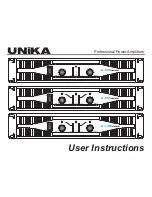
DTDAMP INTRODUCTION
PAGE 4 OF 8
DTD
AMP
introduction
Welcome to the DTD
AMP
manual. Please take some time to read it and
learn how to set up the device.
The DTD
AMP
is an audio power amplifier developed to perfectly match
the NEXO DTD Controller.
It is a pure power amplifier, without any audio processing, thus
ensuring a negligible latency in the feedback loop feeding the DTD
Controller.
Rack installation
The DTD
AMP
should be mounted into a suitable rack unit , ensuring
both front and rear mounting holes are used in order to protect the
amp from mechanical damage.
Air flow of the DTD
AMP
is from front to back, thus installation can mix
both DTD
AMP
(with DTD Controller) and NXAMP in the same rack,
both using the same air flow direction.
Speaker cable choice
W ARNING!
High voltage can be present on the power
amplifier output terminals. Use at least Class 2 wiring cable to connect
the DTD
AMP
to the speakers or to feedback to the DTD.
To minimize power and damping factor losses in speaker cable use
suitable wire gauges from the table bellow.
Load Impedance (Ohms)
4
8
Cable Section
Maximum Length (meters)
1.5 mm² (AWG #14)
6
12
2.5 mm² (AWG #12)
10
20
4 mm² (AWG #10)
16
32
Audio Input and Output connections
How to integrate into the audio chain?
Place the DTD
AMP
in the audio chain just before the speakers, typically
at the output of the DTD Controller.
Typical installation for a touring system (using DTD
AMP
with a DTD-T)
Typical installation for a fixed installation (using DTD
AMP
with a DTD-I)
Note that the outputs of the DTD
AMP
are connected to the DTD-T,
while its integrated front panel patch is used to connect to the
speakers. With the DTD-I, power output of the DTD
AMP
will have to
be spit in two (one side used for DTD-I feedback, the other one going
to the speakers).
W ARNING!
Unplug the device from mains before connecting
or disconnecting any cable to it.
Connecting the DTD
AMP
audio inputs
Use the back panel female XLR3 connectors to connect the balanced
analog input signal, typically from a DTD Controller output.
For each pair of amplifier channels, a LINK switch on the back panel
allows you to use the same input signal (from the lowest channel
number input XLR3) to fed the two amplifier channel. This is useful
when connecting the DTD Controller Mono Sub output to two
amplifiers channels for example.
From DTD Output Input Link switch From DTD Output
Up to ten DTD
AMP
channels can be connected in parallel on one DTD
output.
Connecting the DTD
AMP
power outputs
The DTD
AMP
uses four SP4 outputs to connect the speakers. The pin
out is the following:
Amplifier CH1 outputs on SP4 CH1 1+/1-
Amplifier CH2 outputs on SP4 CH2 1+/1-
Amplifier CH3 outputs on SP4 CH3 1+/1-
Amplifier CH4 outputs on SP4 CH4 1+/1-
DTD
AMP
outputs can be bridged two by two. Note that there is no
switch to use the amplifiers in bridge mode, bridge being always
available with the following pinout:
Amplifier CH1+CH2 (bridge) outputs on SP4 CH1 2+/2-
Amplifier CH1+CH2 (bridge) outputs on SP4 CH2 2+/2-
Amplifier CH3+CH4 (bridge) outputs on SP4 CH3 2+/2-
Amplifier CH3+CH4 (bridge) outputs on SP4 CH4 2+/2-
W ARNING!
Use only the CH1 input (for Bridge CH1 + CH2)
or CH3 input (for Bridge CH3 + CH4) and use the corresponding back
panel LINK switch to use the amplifier in bridge mode.
When used with a DTD-T, DTD
AMP
SP4 outputs are connected to the
DTD-T back panel SP4, while the DTD-T front panel SP4 is connected
to the speakers and subs.
See further for bigger view of the wiring.


























